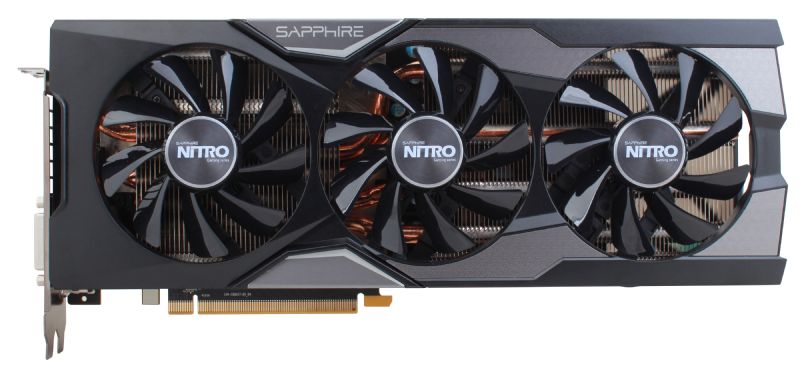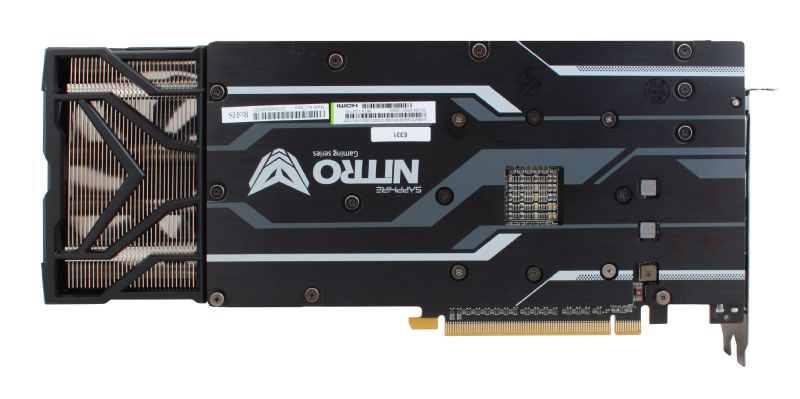Sapphire Launches A New Flagship: Nitro R9 Fury
Sapphire has announced a new flagship graphics card based on AMD’s Fury Pro specifications. The Nitro R9 Fury features a custom PCB with reworked circuitry and a higher overclock than the Tri-X OC Fury we tested last year.
Sapphire’s R9 Fury Tri-X was one of the first overclocked Fury Pro cards to hit the market, and now the company has come back with even more aggressive clock speeds. The Sapphire Nitro R9 Fury has just been announced, and it comes in two flavors. The Nitro R9 Fury OC has a modest 20 MHz overclock, setting the Fiji GPU at 1020 MHz. The Nitro R9 Fury OC+ comes with a more aggressive 1050 MHz overclock, which represents a 50 MHz boost from stock and 10 MHz over Sapphire’s own Tri-X OC edition.
Sapphire’s Nitro R9 Fury shares many of the same features as the Tri-X R9 Fury. Both cards use the same robust Tri-X cooling system, with central 10 mm heat pipe and triple 90 mm fans, and they both include a thick aluminum back plate to aid cooling the backside of the PCB. The main difference between the Tri-X R9 Fury and the newly launched Nitro R9 Fury is the PCB design.
Sapphire said the Nitro R9 Fury’s PCB includes 6-phase circuitry on an 8-layer PCB, which features 2 Oz of copper, enabling Sapphire to push 360 Amps through the GPU. The company said this is to help deliver reliable, stable power while overclocking. Sapphire claimed tha t this results in 20% lower VRM temperatures and higher stable clock speeds.
Sapphire’s Nitro R9 Fury has also been equipped with a dual-BIOS switch. The default setting sets the GPU to 1000 MHz and limits the power draw to 260 W and the GPU temperature to 75 degrees C. The second BIOS is set much more aggressively. The power limit is increased to 300 W, and the GPU temperature target raised to 80 degrees C. With this BIOS, the GPU’s factory setting is 1020 MHz for the OC version and 1050 MHz for the OC+ variant.
Sapphire noted that the Nitro R9 Fury uses Black Diamond chokes, and the design has been optimized to minimize coil noise, which is something we noted to be prominent on the overclocked Tri-X R9 Fury.
| Model | SAPPHIRENITRO R9 FURYOC+ | SAPPHIRE NITRO R9 FURY OC |
|---|---|---|
| Graphicsprocessor | Fiji Pro | Fiji Pro |
| Manufacturing process | 28 nm | 28 nm |
| Memory | 4 GB HBM 4096-bit | 4 GB HBM 4096-bit |
| Stream processors | 3584 | 3584 |
| Texture units | 224 | 224 |
| ROPs | 64 | 64 |
| Engine clock | 1050 MHz (OC+) | 1020 MHz (OC) |
| Memory clock | 500 MHz | 500 MHz |
| Cooling system | Tri-X triple-fancooling with dual-ball bearings, 90mm fans; | Tri-X triple-fancooling with dual-ball bearings, 90mm fans; |
| 5 copper heatpipes(1x 10mm, 2x8mm,2x 6mm), | 5 coppe rheatpipes(1x 10mm, 2x8mm,2x 6mm), | |
| AMD Advanced Fan Control and SAPPHIRE Intelligent Fan Control II | AMD Advanced Fan Control and SAPPHIRE Intelligent Fan Control II | |
| Outputs | 3x DisplayPort,HDMI 1.4a,DVI-D | 3x DisplayPort,HDMI 1.4a,DVI-D |
| Interface | PCI-Express 3.0 | PCI-Express 3.0 |
| Special features | Dual Firmware (Default &Performance) | Dual Firmware (Default &Performance) |
| Black Diamond Choke | Black Diamond Choke | |
| Technologies | DirectX 12,Vulkan, Mantle, OpenGL 4.5, OpenCL 2.0, AMDFreeSync, AMDCrossFireXDMA (bridgeless), AMD Eyefinity, AMDLiquidVR | DirectX 12,Vulkan, Mantle, OpenGL 4.5, OpenCL 2.0, AMDFreeSync, AMDCrossFireXDMA (bridgeless), AMD Eyefinity, AMDLiquidVR |
The Sapphire Nitro R9 Fury is available now through various retailers and online stores.
Get Tom's Hardware's best news and in-depth reviews, straight to your inbox.
Follow Kevin Carbotte @pumcypuhoy. Follow us on Facebook, Google+, RSS, Twitter and YouTube.
Kevin Carbotte is a contributing writer for Tom's Hardware who primarily covers VR and AR hardware. He has been writing for us for more than four years.

